Mini research-psicolinguistics-12
Download as pptx, pdf1 like189 views
The document summarizes a mini research project on psycholinguistics. It provides background information on the child subject, his parents, and his English teacher. It examines the child's first language acquisition, the parents' approach to language learning, the child's characteristics as a second language learner, and the teacher's instructional approach. The research uses a qualitative methodology with interviews. Key findings include the child's first language being Javanese and Indonesian, the parents' interactionist perspective, the child being active and enjoying play, and the teacher also having an interactionist approach focusing on communication.
1 of 13
Download to read offline
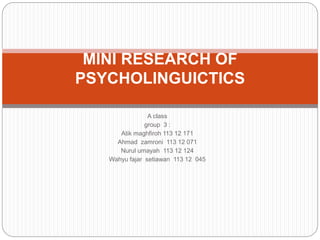
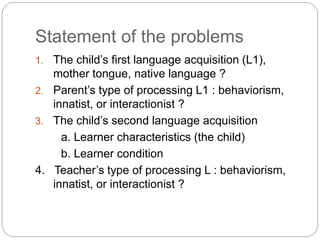
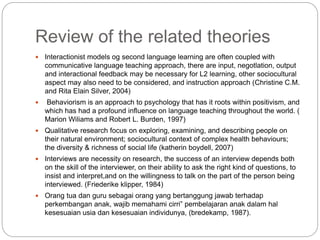
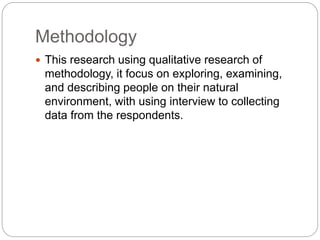
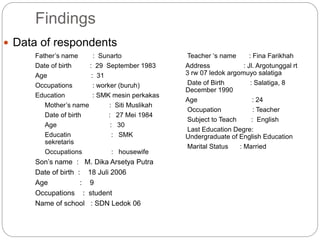

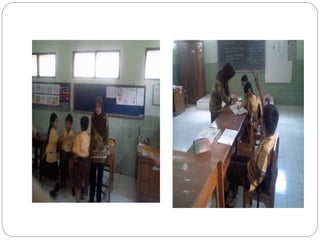
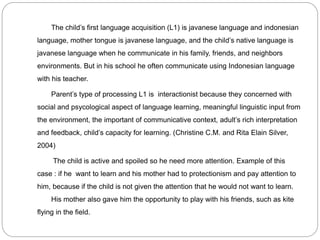
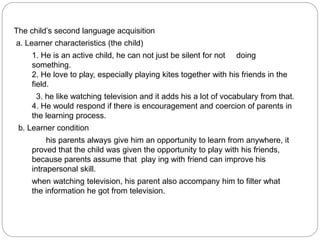
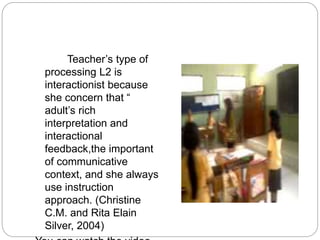

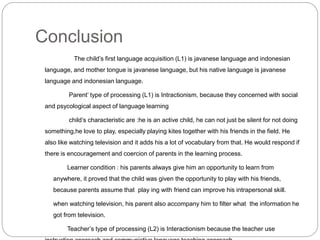
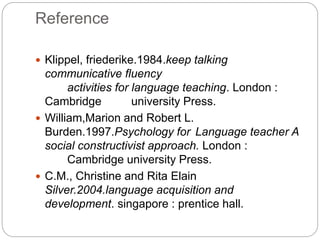
Ad
Recommended
Mini research-psicolinguistics
Mini research-psicolinguisticssaw pedia
╠²
The child's first language is Javanese and Indonesian, with Javanese as his mother tongue. His parents' approach to his first language acquisition is interactionist, focusing on social and psychological aspects of language learning. The child is active and enjoys playing with friends. His parents support his learning by allowing play and filtering television content. The teacher's approach to teaching the child's second language is also interactionist, using instruction and communicative language teaching.Mini research-psicolinguistics
Mini research-psicolinguisticsatikasrofi
╠²
The child's first language is Javanese and Indonesian, with Javanese as his mother tongue. The parents' approach to language learning is interactionist, focusing on social and psychological aspects. The child is active and enjoys playing with friends. For his second language acquisition, he likes watching TV which improves his vocabulary. The teacher's approach is also interactionist, using instruction and communicative language teaching.Mini research of psycholinguistics
Mini research of psycholinguisticsAsna Ristant
╠²
This document contains information about a 10-year-old boy named Gerren. It discusses Gerren's first and second language acquisition, including that his first languages are Javanese and Indonesian, and he is learning English and Arabic as second languages. It describes Gerren as active and curious, though not enjoying English class. It notes that Gerren's parents speak to him in Indonesian and try to encourage English practice at home. The teacher uses interactionist methods like films and games to motivate English learning.MINI RESEARCH ON PSYCHOLINGUICTICS
MINI RESEARCH ON PSYCHOLINGUICTICSsaw pedia
╠²
This document presents a mini research project on psycholinguistics conducted by a group of students. It includes an outline of the research topics, a statement of the research problems regarding first and second language acquisition by a child and their parent and teacher. It then reviews relevant theories on first and second language acquisition. The methodology section describes the research design, subjects of study which is a child, their parent and teacher, and data collection methods. The findings are presented on the child's first language acquisition, the parent's approach, the child's second language acquisition, and the teacher's teaching methods. It concludes with a summary of the key findings.Mini research on psycholinguistic group 3
Mini research on psycholinguistic group 3Tiara Puspitasari
╠²
Rifa Izatun is a 6-year-old girl living in Bancak Village, Semarang, Indonesia. She speaks Javanese as her first language and is acquiring Indonesian as a second language in kindergarten. Both of Rifa's parents, who are Javanese and Sundanese, take an interactive approach to helping her learn Javanese as her first language. Her kindergarten teacher, Mrs. Rafi'ah, also uses an interactive approach with Rifa that incorporates visual aids to help her acquire Indonesian as a second language.Ppt psycholinguistic kelompok7 kelas A
Ppt psycholinguistic kelompok7 kelas Afauziatul hasanah
╠²
The document summarizes a mini research project on psycholinguistics. It discusses the language acquisition of a child named Naura Asyifa. It finds that her first language is Indonesian and Javanese, which she learns from her parents at home and in her environment. The parents' approach to helping her learn is determined to be interactionist, as they frequently engage her in conversation about what she learns.Mini research of psycolinguistic
Mini research of psycolinguisticTiara Puspitasari
╠²
This document contains information about a 10-year-old boy named Gerren. It discusses Gerren's first and second language acquisition, including that his first languages are Javanese and Indonesian, and he is learning English and Arabic as second languages. It describes Gerren as active and curious, and notes that while he doesn't like English class, he can still follow along. It analyzes Gerren's language learning from psycholinguistic and interactionist approaches, noting that his parents encourage English practice at home through movies and games.Mini research psycolinguistic
Mini research psycolinguisticfauziatul hasanah
╠²
1. The child's first language is Javanese, acquired from the home environment, while their native language is Indonesian taught at school.
2. The parent's approach to first language acquisition is interactionism, engaging the child through books, puzzles and stories.
3. For second language acquisition, the child exhibits behaviorist characteristics by imitating, while the parent's approach remains interactionist by asking questions to check understanding.Mini Research in Psycholinguistic
Mini Research in Psycholinguisticatisaida
╠²
This document summarizes a research project on children's first and second language acquisition. It observes one child, Cantika, at a preschool in Semarang, Indonesia. The research finds that Cantika's first language is Bahasa Indonesia due to her parents' emphasis on politeness. Her parents' approach to language teaching is interactionist, focusing on communication and feedback. At preschool, Cantika is learning Javanese, English, and Arabic in addition to her first language. Both her parents and teachers use an interactionist style of language instruction that incorporates conversation and responding to the child's needs.PSYCHOLINGUISTICS/A/5/2015
PSYCHOLINGUISTICS/A/5/2015Danne El Chamel
╠²
The document discusses the first and second language acquisition of a 4-year-old child named Mirza, who speaks Javanese and Indonesian. It explores the interactionist approach of both parents and teachers in Mirza's language development and outlines his learning characteristics and conditions. The research includes observational data and interviews with Mirza's parents and teacher to assess his language acquisition processes.Pshycholinguistic L1 and L2 Acquistion
Pshycholinguistic L1 and L2 Acquistionxfayx
╠²
The document discusses language acquisition in a child named Evania Lillah Tsuroya. It analyzes the child's first language acquisition from her parents and her second language acquisition from her teacher. For the parents, the analysis found that their approach was interactionist. For the teacher, while one feature matched behaviorism, most features matched interactionism, so the teacher's approach was predominantly interactionist. The child's first languages were determined to be Javanese and Bahasa, with English acquired primarily at school.Pshycholinguistic - L1 and L2 Acquisition
Pshycholinguistic - L1 and L2 Acquisitionxfayx
╠²
The document discusses a study on language acquisition. It provides data on a child named Evania Lillah Tsuroya, her mother Umi Nu'amah, and her teacher Surur. Based on an analysis of this data through relevant theories, the following conclusions are drawn:
1) The child's first languages are Javanese and Bahasa.
2) The processing of the child's first language by her parents is best described by the interactionist theory.
3) The child characteristics for acquiring English as a second language are that she is enthusiastic but shy, and acquires English mainly at school.
4) The teacher's processing of the second language can also be characterized by the interactionPSYCHOLINGUISTICS
PSYCHOLINGUISTICSAkhmad Muzaka
╠²
1. The document discusses first and second language acquisition in children. It notes that a child's first language is influenced by their family and environment, while their second language is influenced by instruction and schooling after age 5.
2. Theories of language acquisition discussed include behaviorism, innatism, and interactionism. Behaviorism focuses on observable behaviors, innatism posits an innate language acquisition device, and interactionism considers social and psychological factors.
3. Factors like learner characteristics, learning conditions, and the teacher's approach can influence second language acquisition according to the theories presented.Psycholinguistics/A/1/2015
Psycholinguistics/A/1/2015Fadlilatu Lathifah
╠²
This document discusses Raya, a 5-year-old girl learning two languages from her parents and teacher in Salatiga, Indonesia. Raya's first languages are Bahasa Indonesia and Javanese, as her parents use both at home. Her parents take an interactionist approach to language development, ensuring clear communication. Raya attends kindergarten where her teacher also uses an interactionist model, engaging Raya actively in the classroom using Bahasa Indonesia and sometimes Javanese. Both her parents and teacher recognize the importance of social interaction in facilitating Raya's language acquisition at an early age.Mini research of psycholinguistics
Mini research of psycholinguisticszuliapermata
╠²
This document provides biodata for a child named Muhammad Faqih Baihaqi, his mother Siti Khoiriyah, and his teacher Nurcholis Majid. It examines the child's first language of Javanese and second languages of English and Arabic. The parents take an interactionist approach to language learning by allowing various media but providing supervision, and helping with homework. The teacher also takes an interactionist approach by making lessons engaging through stories and songs, providing practice opportunities, and assisting struggling students.Learner differences
Learner differencesGabriela Paniagua
╠²
This document discusses different contexts for language teaching including EFL, ESL, and ESOL. It describes where teaching takes place such as schools, language schools, one-on-one, and large classes. It also covers learner differences including age, aptitude, learning styles, language levels, methodology, topics, and individual variations based on neuro-linguistic programming and multiple intelligences theory. Finally, it questions what can be done with individual differences in language teaching.Final proyect essay-MaharaSoberanes
Final proyect essay-MaharaSoberanesNidia Favela
╠²
The document summarizes a play about a boy named Waldo who is suffering bullying in his English class in Mexico. Waldo is from the United States and is acquiring English as a second language. His teacher uses traditional, authoritarian teaching methods that prevent students from participating and expressing doubts. Waldo's mother sees he is struggling and asks a TV show for help addressing the problems he faces in school. The show highlights issues with the teacher's approach and lack of support for students like Waldo based on theories of second language acquisition and learning styles. It emphasizes the need for teachers to be flexible, supportive and use a variety of teaching methods to help all students learn.Teaching Grammar - 2- Corrected
Teaching Grammar - 2- Corrected Hanan Alrefai
╠²
This document provides details about an activity to teach 12-year old students about using the simple present tense third person singular correctly. The activity involves a quiz with sentences for students to identify whether the verb used with a third person subject is in the simple present or third person singular form. The purpose is for students to learn when to use the third person singular tense and to enjoy learning through a game. The teacher will first explain the grammar point and check student understanding before having them complete the activity.El enfoque natural
El enfoque naturalGladys Rivera
╠²
The Natural Approach is a language teaching method developed by Tracy Terrell and Stephen Krashen that claims language is acquired similarly to a first language through meaningful communication. It focuses on providing comprehensible input through activities that are slightly above students' current language level. Students first develop comprehension skills through listening and reading before speaking. Speaking emerges gradually without early emphasis on grammatical accuracy. The approach is based on Krashen's theories including the Acquisition-Learning Hypothesis, the Natural Order Hypothesis, the Input Hypothesis, and the Affective Filter Hypothesis.Final Critic Project
Final Critic Projectguest780f83
╠²
Three journal articles examine teacher-student interactions and how they differ by gender. 1) Female teachers interact more with male students, especially in criticism. 2) Error corrections were given to male students twice as much and more explicitly. 3) Classroom discourse access differed by gender, with girls having less opportunities, depending on teacher beliefs and classroom structure.Qualitative research ,the use of songs as a tool to work on listening in efl ...
Qualitative research ,the use of songs as a tool to work on listening in efl ...Lenis Beatriz Marquez Vidal
╠²
This article presents an action research study exploring the use of songs to enhance listening skills and cultural engagement in EFL classes. The findings indicate that integrating songs into lessons motivates students, improves their comprehension, and fosters discussions about cultural and social issues. Overall, songs are deemed effective tools for teaching listening skills and contextualizing language within cultural frameworks.How children learn languages
How children learn languagesAgustina Sarmiento
╠²
(1) There are several stages that children pass through in acquiring their first language from babbling to conversational skills between birth and age 12. The process of acquiring a second language is generally similar but with some key differences due to cognitive development and environment.
(2) Younger does not always mean better for language learning, as many factors like motivation, personality, and resources can influence success. Bilingualism and multilingualism are common for many children.
(3) How teachers think about language learning may influence their classroom practices, so emphasizing what children can do rather than deficits is important. A focus on play, stories, songs and creativity can boost engagement and development.Lesson plan
Lesson plan Manisha Verma
╠²
1) The lesson plan involves students learning about conflicts in the American colonies through a jigsaw activity where they are divided into expert groups to read sections of text and then reconvene in home groups to share their findings. This allows English language learners like Anna to receive support from peers.
2) As an extension, students will role play as representatives of Britain or the colonies to explain conflicts from their perspective and how outcomes affected modern relations.
3) Students will be evaluated based on participation in class activities and demonstration of understanding through a reaction paper, with additional support given to English learners through dialogue journals with the teacher.Do you like learning english?
Do you like learning english? Agustina Ondano
╠²
The document discusses pupils' attitudes towards learning English and the factors that influence their attitudes. It covers 1) how pupils' attitudes are formed and the differences between younger and older children, 2) teachers' views on pupils' attitudes and ways to find out about them, 3) developing positive attitudes through engaging teaching methods like games and songs, and 4) how teachers' own attitudes towards English can impact their students.Ottimizzazione e parallelizzazione del codiceEric Pascolo
╠²
Le document pr├®sente une formule math├®matique r├®p├®t├®e, apparemment li├®e ├Ā un calcul avec des variables 'p' et 'n'. Ces ├®quations semblent ├¬tre une partie d'un travail plus complexe ou d'un algorithme. Le contenu est fragmentaire et ne fournit pas de contexte suppl├®mentaire.Anatomia di una macchina fotografica
Anatomia di una macchina fotograficaEric Pascolo
╠²
Il documento fornisce una dettagliata analisi dell'anatomia di una macchina fotografica, coprendo componenti fondamentali come l'otturatore, le lenti, il diaframma e i sensori. Viene discussa l'importanza della precisione nella costruzione e dei materiali utilizzati, come le leghe di magnesio. L'autore menziona anche aspetti tecnici come la lunghezza focale e la tolleranza nella progettazione della fotocamera.Hpc: usare un computer ├© facile? e un supercomputer?
Hpc: usare un computer ├© facile? e un supercomputer?Eric Pascolo
╠²
Il documento presenta una formula relativa a una variabile t, che si esprime in funzione di altri parametri come n e p. Le diverse espressioni indicate suggeriscono un'analisi specifica di t in relazione a p e n. Tuttavia, il contenuto ├© parzialmente incompleto e richiede ulteriori dettagli per una comprensione completa.Colors
ColorsEric Pascolo
╠²
Il documento esplora la fisica dei colori, evidenziando la loro natura affascinante attraverso basi teoriche, meccanismi ottici e fenomeni ondulatori. Descrive come i colori siano determinati dalle lunghezze d'onda e dalle interazioni della luce con gli atomi e le molecole, con particolare attenzione agli effetti di variazione di energia. Inoltre, si discute il modello del corpo nero e l'influenza della temperatura sulla radiazione emessa da vari materiali.Making the Journey to Customer Marketing 3_BIO
Making the Journey to Customer Marketing 3_BIOPatrick Spencer
╠²
The document discusses the evolution of customer marketing over three eras:
1) Customer Marketing 1.0 (1990s-2002) was a tactical, non-strategic role focused on order taking to support sales, PR, and AR. References were tracked via spreadsheets with no centralized system. Success was measured by lack of complaints.
2) Customer Marketing 2.0 (2004-2011) saw automation of reference management through web-based systems. Third party software-as-a-service providers emerged to replace in-house solutions. Larger organizations consolidated fragmented customer marketing teams.
3) Customer Marketing 3.0 (2012-present) is described as more strategic and data-driven. Advancedb-confident_smb_jan11_cover_story
b-confident_smb_jan11_cover_storyPatrick Spencer
╠²
The document provides a checklist for disaster preparedness based on lessons learned from SMBs that lacked adequate plans. It discusses a 2011 survey finding that half of SMBs do not have an IT disaster plan. Case studies of SMBs that experienced disasters show the high costs incurred without a plan and how those with plans, like using Symantec backup and recovery solutions, were able to recover rapidly. The checklist recommends doing an assessment of needs, creating a plan, implementing solutions, testing the plan, and maintaining preparedness.More Related Content
What's hot (16)
Mini Research in Psycholinguistic
Mini Research in Psycholinguisticatisaida
╠²
This document summarizes a research project on children's first and second language acquisition. It observes one child, Cantika, at a preschool in Semarang, Indonesia. The research finds that Cantika's first language is Bahasa Indonesia due to her parents' emphasis on politeness. Her parents' approach to language teaching is interactionist, focusing on communication and feedback. At preschool, Cantika is learning Javanese, English, and Arabic in addition to her first language. Both her parents and teachers use an interactionist style of language instruction that incorporates conversation and responding to the child's needs.PSYCHOLINGUISTICS/A/5/2015
PSYCHOLINGUISTICS/A/5/2015Danne El Chamel
╠²
The document discusses the first and second language acquisition of a 4-year-old child named Mirza, who speaks Javanese and Indonesian. It explores the interactionist approach of both parents and teachers in Mirza's language development and outlines his learning characteristics and conditions. The research includes observational data and interviews with Mirza's parents and teacher to assess his language acquisition processes.Pshycholinguistic L1 and L2 Acquistion
Pshycholinguistic L1 and L2 Acquistionxfayx
╠²
The document discusses language acquisition in a child named Evania Lillah Tsuroya. It analyzes the child's first language acquisition from her parents and her second language acquisition from her teacher. For the parents, the analysis found that their approach was interactionist. For the teacher, while one feature matched behaviorism, most features matched interactionism, so the teacher's approach was predominantly interactionist. The child's first languages were determined to be Javanese and Bahasa, with English acquired primarily at school.Pshycholinguistic - L1 and L2 Acquisition
Pshycholinguistic - L1 and L2 Acquisitionxfayx
╠²
The document discusses a study on language acquisition. It provides data on a child named Evania Lillah Tsuroya, her mother Umi Nu'amah, and her teacher Surur. Based on an analysis of this data through relevant theories, the following conclusions are drawn:
1) The child's first languages are Javanese and Bahasa.
2) The processing of the child's first language by her parents is best described by the interactionist theory.
3) The child characteristics for acquiring English as a second language are that she is enthusiastic but shy, and acquires English mainly at school.
4) The teacher's processing of the second language can also be characterized by the interactionPSYCHOLINGUISTICS
PSYCHOLINGUISTICSAkhmad Muzaka
╠²
1. The document discusses first and second language acquisition in children. It notes that a child's first language is influenced by their family and environment, while their second language is influenced by instruction and schooling after age 5.
2. Theories of language acquisition discussed include behaviorism, innatism, and interactionism. Behaviorism focuses on observable behaviors, innatism posits an innate language acquisition device, and interactionism considers social and psychological factors.
3. Factors like learner characteristics, learning conditions, and the teacher's approach can influence second language acquisition according to the theories presented.Psycholinguistics/A/1/2015
Psycholinguistics/A/1/2015Fadlilatu Lathifah
╠²
This document discusses Raya, a 5-year-old girl learning two languages from her parents and teacher in Salatiga, Indonesia. Raya's first languages are Bahasa Indonesia and Javanese, as her parents use both at home. Her parents take an interactionist approach to language development, ensuring clear communication. Raya attends kindergarten where her teacher also uses an interactionist model, engaging Raya actively in the classroom using Bahasa Indonesia and sometimes Javanese. Both her parents and teacher recognize the importance of social interaction in facilitating Raya's language acquisition at an early age.Mini research of psycholinguistics
Mini research of psycholinguisticszuliapermata
╠²
This document provides biodata for a child named Muhammad Faqih Baihaqi, his mother Siti Khoiriyah, and his teacher Nurcholis Majid. It examines the child's first language of Javanese and second languages of English and Arabic. The parents take an interactionist approach to language learning by allowing various media but providing supervision, and helping with homework. The teacher also takes an interactionist approach by making lessons engaging through stories and songs, providing practice opportunities, and assisting struggling students.Learner differences
Learner differencesGabriela Paniagua
╠²
This document discusses different contexts for language teaching including EFL, ESL, and ESOL. It describes where teaching takes place such as schools, language schools, one-on-one, and large classes. It also covers learner differences including age, aptitude, learning styles, language levels, methodology, topics, and individual variations based on neuro-linguistic programming and multiple intelligences theory. Finally, it questions what can be done with individual differences in language teaching.Final proyect essay-MaharaSoberanes
Final proyect essay-MaharaSoberanesNidia Favela
╠²
The document summarizes a play about a boy named Waldo who is suffering bullying in his English class in Mexico. Waldo is from the United States and is acquiring English as a second language. His teacher uses traditional, authoritarian teaching methods that prevent students from participating and expressing doubts. Waldo's mother sees he is struggling and asks a TV show for help addressing the problems he faces in school. The show highlights issues with the teacher's approach and lack of support for students like Waldo based on theories of second language acquisition and learning styles. It emphasizes the need for teachers to be flexible, supportive and use a variety of teaching methods to help all students learn.Teaching Grammar - 2- Corrected
Teaching Grammar - 2- Corrected Hanan Alrefai
╠²
This document provides details about an activity to teach 12-year old students about using the simple present tense third person singular correctly. The activity involves a quiz with sentences for students to identify whether the verb used with a third person subject is in the simple present or third person singular form. The purpose is for students to learn when to use the third person singular tense and to enjoy learning through a game. The teacher will first explain the grammar point and check student understanding before having them complete the activity.El enfoque natural
El enfoque naturalGladys Rivera
╠²
The Natural Approach is a language teaching method developed by Tracy Terrell and Stephen Krashen that claims language is acquired similarly to a first language through meaningful communication. It focuses on providing comprehensible input through activities that are slightly above students' current language level. Students first develop comprehension skills through listening and reading before speaking. Speaking emerges gradually without early emphasis on grammatical accuracy. The approach is based on Krashen's theories including the Acquisition-Learning Hypothesis, the Natural Order Hypothesis, the Input Hypothesis, and the Affective Filter Hypothesis.Final Critic Project
Final Critic Projectguest780f83
╠²
Three journal articles examine teacher-student interactions and how they differ by gender. 1) Female teachers interact more with male students, especially in criticism. 2) Error corrections were given to male students twice as much and more explicitly. 3) Classroom discourse access differed by gender, with girls having less opportunities, depending on teacher beliefs and classroom structure.Qualitative research ,the use of songs as a tool to work on listening in efl ...
Qualitative research ,the use of songs as a tool to work on listening in efl ...Lenis Beatriz Marquez Vidal
╠²
This article presents an action research study exploring the use of songs to enhance listening skills and cultural engagement in EFL classes. The findings indicate that integrating songs into lessons motivates students, improves their comprehension, and fosters discussions about cultural and social issues. Overall, songs are deemed effective tools for teaching listening skills and contextualizing language within cultural frameworks.How children learn languages
How children learn languagesAgustina Sarmiento
╠²
(1) There are several stages that children pass through in acquiring their first language from babbling to conversational skills between birth and age 12. The process of acquiring a second language is generally similar but with some key differences due to cognitive development and environment.
(2) Younger does not always mean better for language learning, as many factors like motivation, personality, and resources can influence success. Bilingualism and multilingualism are common for many children.
(3) How teachers think about language learning may influence their classroom practices, so emphasizing what children can do rather than deficits is important. A focus on play, stories, songs and creativity can boost engagement and development.Lesson plan
Lesson plan Manisha Verma
╠²
1) The lesson plan involves students learning about conflicts in the American colonies through a jigsaw activity where they are divided into expert groups to read sections of text and then reconvene in home groups to share their findings. This allows English language learners like Anna to receive support from peers.
2) As an extension, students will role play as representatives of Britain or the colonies to explain conflicts from their perspective and how outcomes affected modern relations.
3) Students will be evaluated based on participation in class activities and demonstration of understanding through a reaction paper, with additional support given to English learners through dialogue journals with the teacher.Do you like learning english?
Do you like learning english? Agustina Ondano
╠²
The document discusses pupils' attitudes towards learning English and the factors that influence their attitudes. It covers 1) how pupils' attitudes are formed and the differences between younger and older children, 2) teachers' views on pupils' attitudes and ways to find out about them, 3) developing positive attitudes through engaging teaching methods like games and songs, and 4) how teachers' own attitudes towards English can impact their students.Qualitative research ,the use of songs as a tool to work on listening in efl ...
Qualitative research ,the use of songs as a tool to work on listening in efl ...Lenis Beatriz Marquez Vidal
╠²
Viewers also liked (18)
Ottimizzazione e parallelizzazione del codiceEric Pascolo
╠²
Le document pr├®sente une formule math├®matique r├®p├®t├®e, apparemment li├®e ├Ā un calcul avec des variables 'p' et 'n'. Ces ├®quations semblent ├¬tre une partie d'un travail plus complexe ou d'un algorithme. Le contenu est fragmentaire et ne fournit pas de contexte suppl├®mentaire.Anatomia di una macchina fotografica
Anatomia di una macchina fotograficaEric Pascolo
╠²
Il documento fornisce una dettagliata analisi dell'anatomia di una macchina fotografica, coprendo componenti fondamentali come l'otturatore, le lenti, il diaframma e i sensori. Viene discussa l'importanza della precisione nella costruzione e dei materiali utilizzati, come le leghe di magnesio. L'autore menziona anche aspetti tecnici come la lunghezza focale e la tolleranza nella progettazione della fotocamera.Hpc: usare un computer ├© facile? e un supercomputer?
Hpc: usare un computer ├© facile? e un supercomputer?Eric Pascolo
╠²
Il documento presenta una formula relativa a una variabile t, che si esprime in funzione di altri parametri come n e p. Le diverse espressioni indicate suggeriscono un'analisi specifica di t in relazione a p e n. Tuttavia, il contenuto ├© parzialmente incompleto e richiede ulteriori dettagli per una comprensione completa.Colors
ColorsEric Pascolo
╠²
Il documento esplora la fisica dei colori, evidenziando la loro natura affascinante attraverso basi teoriche, meccanismi ottici e fenomeni ondulatori. Descrive come i colori siano determinati dalle lunghezze d'onda e dalle interazioni della luce con gli atomi e le molecole, con particolare attenzione agli effetti di variazione di energia. Inoltre, si discute il modello del corpo nero e l'influenza della temperatura sulla radiazione emessa da vari materiali.Making the Journey to Customer Marketing 3_BIO
Making the Journey to Customer Marketing 3_BIOPatrick Spencer
╠²
The document discusses the evolution of customer marketing over three eras:
1) Customer Marketing 1.0 (1990s-2002) was a tactical, non-strategic role focused on order taking to support sales, PR, and AR. References were tracked via spreadsheets with no centralized system. Success was measured by lack of complaints.
2) Customer Marketing 2.0 (2004-2011) saw automation of reference management through web-based systems. Third party software-as-a-service providers emerged to replace in-house solutions. Larger organizations consolidated fragmented customer marketing teams.
3) Customer Marketing 3.0 (2012-present) is described as more strategic and data-driven. Advancedb-confident_smb_jan11_cover_story
b-confident_smb_jan11_cover_storyPatrick Spencer
╠²
The document provides a checklist for disaster preparedness based on lessons learned from SMBs that lacked adequate plans. It discusses a 2011 survey finding that half of SMBs do not have an IT disaster plan. Case studies of SMBs that experienced disasters show the high costs incurred without a plan and how those with plans, like using Symantec backup and recovery solutions, were able to recover rapidly. The checklist recommends doing an assessment of needs, creating a plan, implementing solutions, testing the plan, and maintaining preparedness.Schleswig-Holsteins - Logistics hub of the northWTSH
╠²
Schleswig-Holstein serves as a key logistics hub in Europe, strategically located between the North Sea and the Baltic Sea, providing excellent transport connections for trade and industries. The region's infrastructure supports efficient logistics and has a strong presence in the maritime sector, with major ports like Kiel, L├╝beck, and Hamburg facilitating substantial cargo traffic. With favorable conditions for global market access, Schleswig-Holstein is increasingly attractive for logistics firms and companies that transport goods internationally.10 Self-Affirmation for Recovery
10 Self-Affirmation for RecoverySoberlink
╠²
Self-affirmation is the recognition of one's personal value, essential during recovery for mental health. Practicing daily self-affirmations can enhance confidence and resilience, helping individuals develop a positive perspective on their journey. A list of 10 affirmations is provided to support this practice, encouraging individuals to incorporate them into their daily routine.Master presentation-21-7-2014
Master presentation-21-7-2014Panagiotis Garefalakis
╠²
This master's thesis proposes a distributed key-value store based on replicated LSM trees. The main contributions are a high-performance data replication primitive that combines the ZAB protocol with LSM tree implementation, and a technique for changing replication group leaders prior to heavy compactions to improve write throughput by up to 60%. Evaluation shows the system outperforms Apache Cassandra and Oracle NoSQL. Future work includes adding elasticity and optimizing Zookeeper load balancing.Trabajo ed fisica 2Sebastian Salinas Ledesma
╠²
El juego de handbowling consiste en realizar 6 pases alternando entre la mano y el pie a trav├®s de un arco con 3 conos, con el objetivo de derribar los 3 conos. Las reglas estipulan que los pases deben contarse en voz alta, no se puede quitar el bal├│n de las manos, y si el bal├│n se intercepta o cae se debe volver a empezar desde cero. Los principios t├Īcticos clave son la comunicaci├│n, ocupaci├│n de espacios, l├Łnea de pases, triangulaci├│n y simplicidad.Seminario 5-Estado gaseosomvclarke
╠²
El documento describe los diferentes estados de agregaci├│n de la materia, incluyendo s├│lido, l├Łquido, gaseoso, plasm├Ītico, condensado de Bose-Einstein y condensado de Fermi. Explica las propiedades caracter├Łsticas de cada estado y c├│mo las part├Łculas se mueven y interact├║an. Tambi├®n describe los cambios de estado de la materia como fusi├│n, vaporizaci├│n y ebullici├│n, y las leyes que rigen el comportamiento de los gases.Commit to building new leadership habits
Commit to building new leadership habitsEuna Rhodes
╠²
The document discusses building new leadership habits to achieve career goals in 2015. It recommends assessing current management practices such as communicating goals, providing feedback, and holding people accountable. A framework is then presented for developing new weekly habits like anchoring on Mondays to focus on strategic goals, reinforcing goals and metrics on Tuesdays, coaching team members on Wednesdays, executing personal work on Thursdays, investing in team members on Fridays, rejuvenating without work on Saturdays, and reflecting on Sundays. Following this framework is intended to help align habits with intentions, clarify the mission to the team, improve coaching, drive consistent execution, and achieve stellar results.Content Delivery
Content DeliveryChris Grannell
╠²
The document discusses issues with manual content delivery including multiple formats, lack of standard syntax, and flat data. Specifically, it notes that data within retail channels is often incorrect or missing, creating additional costs.Macp Work
Macp WorkMarco Mastrangeli
╠²
MACP is a compact air cushion platform that can be configured for different operations. It is the most compact hovercraft approved for professional use, with an impact-resistant and unsinkable soft hull that makes it well-suited to very shallow water surveys, difficult areas with strong currents or debris. The MACP can carry sensors and equipment inside its hull while moving slowly in water or over land on an air cushion, and can tow other MACPs or equipment to form larger work platforms.La bella y la bestiaJessica Victoria Pintos Farias
╠²
La canci├│n narra la historia de una mujer (Bella) en una relaci├│n abusiva con un hombre (La Bestia). Al principio la relaci├│n parece ir bien, pero con el tiempo la Bestia se vuelve agresivo, celoso y violento, llegando a golpear a Bella. Bella se siente atrapada y con miedo, pero tambi├®n quiere salir de la relaci├│n. Al final, Bella decide que ya no puede soportar m├Īs la violencia y busca la forma de liberarse de la Bestia.Better Together
Better TogetherSoberlink
╠²
The document emphasizes the importance of community in the recovery journey from addiction, highlighting that shared experiences foster connection and support. Key characteristics of a healthy recovery community include support, confidence, and honesty, which all contribute to individual growth and accountability. For those not ready to engage physically, digital platforms like Facebook groups or apps can still provide valuable support and connection.ÓĖ½ÓĖ▓3ÓĖĀÓĖ×ÓĖłÓĖÖÓ╣ĆÓĖłÓĖŁ2016 ÓĖüÓĖ╣ÓĖĢÓĖ▒Ó╣ēÓĖćÓ╣āÓĖłÓĖŚÓĖ│ÓĖöÓĖĄÓĖ¬ÓĖĖÓĖöÓĖóÓĖŁÓĖöÓĖüÓĖ▓ÓĖŻÓ╣īÓĖĢÓĖ╣ÓĖÖ48ÓĖéÓ╣ēÓĖŁ2015
ÓĖ½ÓĖ▓3ÓĖĀÓĖ×ÓĖłÓĖÖÓ╣ĆÓĖłÓĖŁ2016 ÓĖüÓĖ╣ÓĖĢÓĖ▒Ó╣ēÓĖćÓ╣āÓĖłÓĖŚÓĖ│ÓĖöÓĖĄÓĖ¬ÓĖĖÓĖöÓĖóÓĖŁÓĖöÓĖüÓĖ▓ÓĖŻÓ╣īÓĖĢÓĖ╣ÓĖÖ48ÓĖéÓ╣ēÓĖŁ2015║▌║▌▀ŻShare-Ó╣ĆÓĖóÓĖŁÓĖ░Ó╣ĆÓĖüÓĖ┤ÓĖÖ-ÓĖüÓĖżÓĖĢÓĖóÓĖ▓ ÓĖ©ÓĖŻÓĖĄÓĖŻÓĖ┤
╠²
ÓĖ½ÓĖ▓3ÓĖĀÓĖ×ÓĖłÓĖÖÓ╣ĆÓĖłÓĖŁ2016 ÓĖüÓĖ╣ÓĖĢÓĖ▒Ó╣ēÓĖćÓ╣āÓĖłÓĖŚÓĖ│ÓĖöÓĖĄÓĖ¬ÓĖĖÓĖöÓĖóÓĖŁÓĖöÓĖüÓĖ▓ÓĖŻÓ╣īÓĖĢÓĖ╣ÓĖÖ48ÓĖéÓ╣ēÓĖŁ2015ÓĖ½ÓĖ▓3ÓĖĀÓĖ×ÓĖłÓĖÖÓ╣ĆÓĖłÓĖŁ2016 ÓĖüÓĖ╣ÓĖĢÓĖ▒Ó╣ēÓĖćÓ╣āÓĖłÓĖŚÓĖ│ÓĖöÓĖĄÓĖ¬ÓĖĖÓĖöÓĖóÓĖŁÓĖöÓĖüÓĖ▓ÓĖŻÓ╣īÓĖĢÓĖ╣ÓĖÖ48ÓĖéÓ╣ēÓĖŁ2015
ÓĖ½ÓĖ▓3ÓĖĀÓĖ×ÓĖłÓĖÖÓ╣ĆÓĖłÓĖŁ2016 ÓĖüÓĖ╣ÓĖĢÓĖ▒Ó╣ēÓĖćÓ╣āÓĖłÓĖŚÓĖ│ÓĖöÓĖĄÓĖ¬ÓĖĖÓĖöÓĖóÓĖŁÓĖöÓĖüÓĖ▓ÓĖŻÓ╣īÓĖĢÓĖ╣ÓĖÖ48ÓĖéÓ╣ēÓĖŁ2015║▌║▌▀ŻShare-Ó╣ĆÓĖóÓĖŁÓĖ░Ó╣ĆÓĖüÓĖ┤ÓĖÖ-ÓĖüÓĖżÓĖĢÓĖóÓĖ▓ ÓĖ©ÓĖŻÓĖĄÓĖŻÓĖ┤
╠²
Ad
Similar to Mini research-psicolinguistics-12 (20)
Mini research-psycolinguistics
Mini research-psycolinguisticsatikasrofi
╠²
The child's first language is Javanese and Indonesian, with Javanese as his mother tongue. The parents' approach to language learning is interactionist, focusing on social and psychological aspects. The child is active and enjoys playing with friends. For his second language acquisition, he likes watching TV which improves his vocabulary. The teacher's approach is also interactionist, using instruction and communicative language teaching.Psycholinguistics
PsycholinguisticsFitri M
╠²
The document discusses first and second language acquisition in a child. It provides details about the child respondent, her mother and teacher. It finds that the child uses code-mixing of Javanese and Indonesian as her first language. The mother's processing of the child's first language follows an interactionist approach, providing meaningful input and focusing on communication. For second language acquisition, the child learns English in school through a behaviorist approach focusing on speaking, listening and practice, while her mother provides guidance at home.Psycholinguistics,class b, group 2, 2015
Psycholinguistics,class b, group 2, 2015Tiara Puspitasari
╠²
This document contains information about a 10-year-old boy named Gerren. It discusses Gerren's first and second language acquisition, including that his first languages are Javanese and Indonesian, and he is learning English and Arabic as second languages. It describes Gerren as active and curious, though not enjoying English class. It notes that Gerren's parents speak to him in Indonesian and try to encourage English practice at home. The teacher uses interactionist methods like films and games to motivate English learning.Mini Research on Psycholinguistics
Mini Research on PsycholinguisticsRiyabadariya Riya
╠²
The document summarizes a mini research project on psycholinguistics. It discusses the first and second language acquisition of a child based on observations of the child, interviews with her parents and teacher, and a review of language acquisition theories. The research found that the child's first language is Indonesian and Javanese, acquired from her parents at home and in her environment. It was determined that the parents' and teacher's approach to language learning for the child is most consistent with interactionism.Mini research on psycholinguistic group 1
Mini research on psycholinguistic group 1Tiara Puspitasari
╠²
The document summarizes a mini research project on child language acquisition. It discusses the subject of the study, a 3-year old girl named Lailia Arumi Zahra. It analyzes her first language acquisition from her parents using an interactionist approach. It finds her second language acquisition in her play group is facilitated through a behaviorist teaching style, with habitual activities and modeling. The teacher also occasionally demonstrates interactionist qualities by engaging students in discussions.Mini research on psycholinguistic group 1
Mini research on psycholinguistic group 1Tiara Puspitasari
╠²
The document summarizes a mini research project on child language acquisition. It discusses the first and second language acquisition of a 3-year-old child named Lailia Arumi Zahra. It finds that her first languages are Javanese and Bahasa, with a little English as a second language. It also finds that her parents use an interactionist approach to processing her first language, while her teacher uses mostly a behaviorist approach but sometimes interactionist as well.PSYCHOLINGUISTIC/A/5/2015
PSYCHOLINGUISTIC/A/5/2015Danne El Chamel
╠²
The document discusses the first and second language acquisition of a 4-year-old child, Mirza, focusing on the influence of his parents' and teacher's methods, classified as behaviorist, innatist, and interactionist. It details Mirza's language use at home, his characteristics as a learner, and the educational strategies employed by his teacher. Research methods included observations and interviews with Mirza's parents and teacher to gather data on his language development and learning environment.PSYCHOLINGUISTIC/B/6/2015
PSYCHOLINGUISTIC/B/6/2015Nofi Nh
╠²
Nui is an 8-year-old girl acquiring language. Her first languages are Bahasa and Sundanese from her parents. She is now learning English and Arabic as a second languages. Nui's mother uses an interactionist approach to teaching Sundanese, engaging with Nui and responding to her needs. Nui's teacher also uses an interactionist approach in teaching Bahasa and Javanese, allowing students to practice and explore through interaction. Nui is progressing well in acquiring her second languages due to support from her family and school.PSYCHOLINGUISTIC/B/6/2015
PSYCHOLINGUISTIC/B/6/2015Nofi Nh
╠²
This document discusses Nui's language acquisition process from the perspectives of her mother, teacher, and researchers. Nui's first language is Bahasa and Sundanese, as her mother's native languages are also Sundanese and Bahasa. Her teacher teaches in Bahasa and Javanese in the classroom. Both Nui's mother and teacher take an interactionist approach to language processing, focusing on social interaction and guided practice to help Nui acquire languages.PSYCHOLINGUISTIC/B/6/2015
PSYCHOLINGUISTIC/B/6/2015Nofi Nh
╠²
Nui's first languages are Bahasa and Sundanese. Her mother teaches her Sundanese through social interaction and practice. Nui learns English and Arabic as second languages, and her teacher guides her learning through interaction and practice. Both the parent and teacher use interactionist approaches to help Nui acquire language skills.Psycholinguistics/A/1/2015
Psycholinguistics/A/1/2015Fadlilatu Lathifah
╠²
This document discusses Raya, a 5-year-old girl learning two languages from her parents and teacher in Salatiga, Indonesia. Raya's first languages are Bahasa Indonesia and Javanese, as her parents use both at home. Her parents take an interactionist approach to language development, communicating frequently with Raya. Her teacher also uses interactionist methods like reciprocal communication between Raya and himself, sometimes using Javanese to aid understanding. The models of Raya's language acquisition align with Vygotsky's Zone of Proximal Development and interactionist views of second language learning through environmental immersion and use.The recent history of second language learning research sla -presentation...
The recent history of second language learning research sla -presentation...jannesar_m
╠²
This document provides a summary of the major developments in second language learning research from the 1950s to the 1970s. It discusses key theories and models that emerged during this period, including: structuralism in the 1950s, which viewed language learning as acquiring speech habits; behaviourism in the 1950s-60s, which saw it as forming stimulus-response habits; first language acquisition research in the 1960s-70s, which looked at universal stages of development; error analysis and the concept of interlanguage in the 1970s, which viewed learner language as its own rule-governed system; Krashen's Monitor Model of the 1970s, including the acquisition-learning distinction and his input, natural order, monitor,Compare and Contrast First and Second Language Acquisition
Compare and Contrast First and Second Language AcquisitionIsna Dwi Setianingsih
╠²
The document discusses similarities and differences between first language (L1) and second language (L2) acquisition. Some key similarities include that both involve predictable developmental stages, making errors is part of the learning process, and age affects proficiency. However, there are also differences, such as L1 acquisition nearly always leads to perfect mastery while this is unlikely for L2, and affective factors play a larger role in L2 acquisition. The document emphasizes that language acquisition is complex with many interacting factors, so teachers should consider multiple claims rather than basing instruction on a single idea.SLA ,Learning Theories , Second language Aquisition
SLA ,Learning Theories , Second language Aquisitionmoji azimi
╠²
This document discusses theories of second language acquisition (SLA). It covers linguistic, psychological, and sociocultural theories including: Universal Grammar, Monitor Theory, Natural Order Hypothesis, Comprehension Input Hypothesis, Affective Filter Hypothesis, Behaviorism, Contrastive Analysis Hypothesis, Cognitive Psychology, Information Processing Theory, Connectionism, Processability Theory, Interactionist Perspectives, Sociocultural Perspectives, Interlanguage, Developmental Sequences, and the role of the first language and instruction in SLA. The document provides an overview of many influential theories that aim to explain how people learn a second language.Principles of language learning and teaching
Principles of language learning and teachingKarina Vanesa P├®rez S├Īnchez
╠²
This document outlines the chapters of a book on principles of language learning and teaching. It covers topics such as first and second language acquisition, the influence of age on acquisition, learning styles and strategies, sociocultural factors, theories of second language acquisition, and developing communicative competence. Each chapter describes key concepts and theories in its subject area and discusses implications for language teaching methodology.First and second language acquisition
First and second language acquisitioneTeachAbroad
╠²
The document discusses various topics related to first and second language acquisition including different teaching methods, theories of second language acquisition, and characteristics of first language acquisition. It also covers the psychosocial aspects of language learning based on Piaget and Vygotsky's theories. Finally, it discusses social and discourse aspects of interlanguage as well as psycholinguistic aspects such as language transfer and processing operations.Theories of language learning.ppt
Theories of language learning.pptMUHAMMAD ASIF IKRAM ANJUM
╠²
This document outlines theories of language learning, covering historical background, basic concepts, key issues, and approaches. It discusses the shift from practice-oriented to theory-oriented study, and the development of related fields. Key concepts covered include the differences between L1, L2, and FL. Approaches discussed include the linguistic approach, functional-typological approach, information processing/cognitive approach, and socio-cultural approach. Current issues focus on the cognitive underpinnings of L2 learning and representation of multiple languages in the brain.Tema 2
Tema 2 Elena (IES Cervantes)
╠²
1. The document discusses several theories of first and second language acquisition, including imitation theory, innateness theory, cognition theory, input theory, and behaviorism.
2. It notes key differences between first and second language acquisition, such as L1 acquisition typically occurring before age 5 while L2 occurs later, and L2 learners being unable to fully process language like native speakers.
3. Several theories of second language acquisition are also covered, including accomodation theory, the acculturation model, discourse theory, and Krashen's Monitor model which distinguishes acquisition vs. learning.ŃĆÉBook PresentationŃĆæEllis and shintani (2014). chapter 1 (JACET Reading Resear...
ŃĆÉBook PresentationŃĆæEllis and shintani (2014). chapter 1 (JACET Reading Resear...Yu Kanazawa / Osaka University
╠²
The document provides an extensive exploration of second language acquisition (SLA) research and its implications for language pedagogy. It covers key topics such as behaviorist and mentalist approaches, interlanguage theory, the role of input and output, consciousness in learning, and social perspectives on SLA. Furthermore, it outlines principles for effective language instruction, emphasizing a balance between implicit and explicit knowledge, engagement with comprehensible input, and consideration of individual learner differences.ŃĆÉBook PresentationŃĆæEllis and shintani (2014). chapter 1 (JACET Reading Resear...
ŃĆÉBook PresentationŃĆæEllis and shintani (2014). chapter 1 (JACET Reading Resear...Yu Kanazawa / Osaka University
╠²
Ad
Mini research-psicolinguistics-12
- 1. A class group 3 : Atik maghfiroh 113 12 171 Ahmad zamroni 113 12 071 Nurul umayah 113 12 124 Wahyu fajar setiawan 113 12 045 MINI RESEARCH OF PSYCHOLINGUICTICS
- 2. Statement of the problems 1. The childŌĆÖs first language acquisition (L1), mother tongue, native language ? 2. ParentŌĆÖs type of processing L1 : behaviorism, innatist, or interactionist ? 3. The childŌĆÖs second language acquisition a. Learner characteristics (the child) b. Learner condition 4. TeacherŌĆÖs type of processing L : behaviorism, innatist, or interactionist ?
- 3. Review of the related theories ’éŚ Interactionist models og second language learning are often coupled with communicative language teaching approach, there are input, negotlation, output and interactional feedback may be necessary for L2 learning, other sociocultural aspect may also need to be considered, and instruction approach (Christine C.M. and Rita Elain Silver, 2004) ’éŚ Behaviorism is an approach to psychology that has it roots within positivism, and which has had a profound influence on language teaching throughout the world. ( Marion Wiliams and Robert L. Burden, 1997) ’éŚ Qualitative research focus on exploring, examining, and describing people on their natural environment; sociocultural context of complex health behaviours; the diversity & richness of social life (katherin boydell, 2007) ’éŚ Interviews are necessity on research, the success of an interview depends both on the skill of the interviewer, on their ability to ask the right kind of questions, to insist and interpret,and on the willingness to talk on the part of the person being interviewed. (Friederike klipper, 1984) ’éŚ Orang tua dan guru sebagai orang yang bertanggung jawab terhadap perkembangan anak, wajib memahami cirriŌĆØ pembelajaran anak dalam hal kesesuaian usia dan kesesuaian individunya, (bredekamp, 1987).
- 4. Methodology ’éŚ This research using qualitative research of methodology, it focus on exploring, examining, and describing people on their natural environment, with using interview to collecting data from the respondents.
- 5. Findings FatherŌĆÖs name : Sunarto Date of birth : 29 September 1983 Age : 31 Occupations : worker (buruh) Education : SMK mesin perkakas MotherŌĆÖs name : Siti Muslikah Date of birth : 27 Mei 1984 Age : 30 Educatin : SMK sekretaris Occupations : housewife SonŌĆÖs name : M. Dika Arsetya Putra Date of birth : 18 Juli 2006 Age : 9 Occupations : student Name of school : SDN Ledok 06 Teacher ŌĆśs name : Fina Farikhah Address : Jl. Argotunggal rt 3 rw 07 ledok argomuyo salatiga Date of Birth : Salatiga, 8 December 1990 Age : 24 Occupation : Teacher Subject to Teach : English Last Education Degre: Undergraduate of English Education Marital Status : Married ’éŚ Data of respondents
- 8. The childŌĆÖs first language acquisition (L1) is javanese language and indonesian language, mother tongue is javanese language, and the childŌĆÖs native language is javanese language when he communicate in his family, friends, and neighbors environments. But in his school he often communicate using Indonesian language with his teacher. ParentŌĆÖs type of processing L1 is interactionist because they concerned with social and psycological aspect of language learning, meaningful linguistic input from the environment, the important of communicative context, adultŌĆÖs rich interpretation and feedback, childŌĆÖs capacity for learning. (Christine C.M. and Rita Elain Silver, 2004) The child is active and spoiled so he need more attention. Example of this case : if he want to learn and his mother had to protectionism and pay attention to him, because if the child is not given the attention that he would not want to learn. His mother also gave him the opportunity to play with his friends, such as kite flying in the field.
- 9. The childŌĆÖs second language acquisition a. Learner characteristics (the child) 1. He is an active child, he can not just be silent for not doing something. 2. He love to play, especially playing kites together with his friends in the field. 3. he like watching television and it adds his a lot of vocabulary from that. 4. He would respond if there is encouragement and coercion of parents in the learning process. b. Learner condition his parents always give him an opportunity to learn from anywhere, it proved that the child was given the opportunity to play with his friends, because parents assume that play ing with friend can improve his intrapersonal skill. when watching television, his parent also accompany him to filter what the information he got from television.
- 10. TeacherŌĆÖs type of processing L2 is interactionist because she concern that ŌĆ£ adultŌĆÖs rich interpretation and interactional feedback,the important of communicative context, and she always use instruction approach. (Christine C.M. and Rita Elain Silver, 2004)
- 11. Others videos
- 12. Conclusion The childŌĆÖs first language acquisition (L1) is javanese language and indonesian language, and mother tongue is javanese language, but his native language is javanese language and indonesian language. ParentŌĆÖ type of processing (L1) is Intractionism, because they concerned with social and psycological aspect of language learning childŌĆÖs characteristic are :he is an active child, he can not just be silent for not doing something,he love to play, especially playing kites together with his friends in the field. He also like watching television and it adds his a lot of vocabulary from that. He would respond if there is encouragement and coercion of parents in the learning process. Learner condition : his parents always give him an opportunity to learn from anywhere, it proved that the child was given the opportunity to play with his friends, because parents assume that play ing with friend can improve his intrapersonal skill. when watching television, his parent also accompany him to filter what the information he got from television. TeacherŌĆÖs type of processing (L2) is Interactionism because the teacher use
- 13. Reference ’éŚ Klippel, friederike.1984.keep talking communicative fluency activities for language teaching. London : Cambridge university Press. ’éŚ William,Marion and Robert L. Burden.1997.Psychology for Language teacher A social constructivist approach. London : Cambridge university Press. ’éŚ C.M., Christine and Rita Elain Silver.2004.language acquisition and development. singapore : prentice hall.
